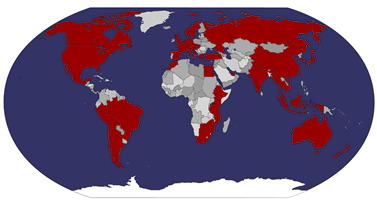
La Serena
La Serena is cool. It's got a mediterranean feel to it, with sandstone and colonial-style buildings, palm-tree lined avenues and a very balmy air.

Beautiful town centre
There hasn't been a single cloud breaching the horizon the whole day, and it's pretty hot, but pleasant because of a gentle sea-breeze rolling off the sea.

Wiring fun
My hostel has a hammock in the back garden, and very nice it is too, gently rocking back and forth. Reminds me of Navimag but without the incessant announcements and dry bread! I stayed last night in Hostel El Punto, another place just a few doors along, and clearly the place to stay here, being run by a load of cool German girls who know exactly what backpackers long for. Now I'm in Hostel Gregorio Fernandez, which is a bit grimier, dated, but has the garden and an enormous paddling pool that I might be able to get some backstroke swimming done in - I think two strokes should do for the length!


The other amazing thing to note is that there is culture here! How unlike Puerto Montt! There's a literary festival on at the moment, and the main square is lined with temporary book stores. I'm sitting writing this in Café de Brasil, which has a reasonable expresso, though I've steered clear of the cappuccino, which has some suspicious ingredients listed. It's Valentine's Day, so the whole town is swarming with smoochy couples, so I'll presumably have to steer clear of any vaguely nice restaurants. Perhaps a hotdog instead!

Damn lovebirds

I've managed to change my flights to leave South America a week later than planned, i.e. 7th March, for Easter Island. I wasn't able to make route changes though, apparently I have to do that with Qantas in Santiago. Why? Don't ask, don't bl**dy ask. Damn OneWorld alliance! In the evening I walked down to the beach, then along the bay, to find a restaurant called Glady's.

I walked for absolutely miles. It must have been 2 and a half hour's walk before I gave up and started walking back. Strange seeing Punch and Judy shows at half-midnight on the beach.. Different culture here! The seafood I had at the restaurant I picked was nice - I ate a white fish called a vieje, which was pleasant although not amazingly flavoursome - where was the chilli sauce when I needed it?

A tidal wave would be the fastest way back to my hostel

I feel drawn to this bar for some reason
Elqui Valley
Early start next day for the Elqui valley trip. This is a fertile "oasis" valley near here, surrounded by desert and mountains. I should explain that this whole region is at the edge of the Atacama Desert, and hence is generally very dry, and would be very hot but for the seemingly consistent sea breeze. The Elqui valley has a river flowing down it which ensures plenty of greenery and fertile land on the relatively narrow valley floor, despite the barron mountains lining the valley, on which nothing but cacti survive (bearing a delicious fruit similar to a kiwi called a copao).


Copaos

Copaos being enjoyed by Brazilian Jonas
The river is dammed half way up the valley, presumably to ensure a consistent flow of water to the plain below.

There are all sorts of things growing in the valley, all at relatively small scale. We stop at a papaya plantation, but these are different from normal papayas, being very acidic, to the point that they would burn without being diluted and sugared before drinking or eating them. Apparently they have many medicinal uses, and can be used to clean brass etc.

We head up the valley in our bus, passing orange groves, lemons, strawberries, apples, and lots of vineyards, the grapes of which are used to produce wine, Huancara, a fortified wine introduced by Jesuits, and the most famous export from the valley, Pisco, a spirit similar to grappa from Italy.

Did the Moai drink Pisco? I doubt it.
So we do a tour of the largest Pisco distillery, that of Capel, just outside of Vicuña [GPS: 30.03912S, 70.69799W]. The basic process is that they take grapes from the farmers, the sweeter the better (the grapes not farmers, darling), mash them up, get rid of the pulp, boil the liquid then distill it.



It's very similar in process to whiskey, with different strengths being produced, and some piscos being produced solely for blending, others being held in American bourbon casks for several years before being released.


At the end, we have a quick tasting session, which influences me to buy a small bottle of Pisco Sour Premium "Pica", the pica apparently being a lime-like fruit. Cost of bottle - 80p! Even litre bottles of pisco, which is 35-45% proof, were less than £2!

After this aperitif, it's time for lunch. We drive to a restaurant where they cook everything using the sun.

The ovens
We have a choice of goat, cow, chicken or something else. I go with the goat, which turns out okay, not too fatty. It's surprising how fast they cook the food given that it is just solar power. Perhaps they had a microwave out back. We end the day with a visit to the oldest Pisco Distillery, Los Nichos [GPS: 30.15656S, 70.49696], just past Pisco Elqui town.

Nets protect the grapes from wind
Mamalluca Observatory
The Mamalluca Observatory is one of a few in the area for tourists. These are distinct from the professional ones in that you can go to see them at night, use the scopes etc, whereas the "big boys" only allow visits during Saturday afternoon for a couple of hours. I'm supposed to be going to La Silla, the ESO one, this Saturday, but it's next to impossible to get there, and I'm probably going to give up!
So we're picked up at about 9:30pm from the hostel. I've filled up my thermos flask, so am ready for yerba mate action! However, the road is so bumpy that a large proportion of it ends up all over my trousers. Hmmm. Anyway, on the bus with Jonas and an English girl called Sam, and we're all a bit apprehensive because there is blanket cloud covering La Serena. The tour company has called ahead though, and has the all-clear from the observatory - worth doing as it's an hour and a half or so up. About half way there, the clouds roll back, and we are presented with an amazingly clear night sky! Marvellous!
We arrive at the site, atop Cerro Mamalluca, about 1500m up, [GPS: 29.98961S, 70.68491W] and find the English tour group. First we use one of several scopes outside - this one is a 30cm scope, with a 50x multiplier? We take turns looking at some clusters, before heading inside to use the main scope there, a proper tracking one, which we use to look at Saturn. It's amazingly clear, one can see all the rings clearly, and some surface detail. In fact, it looks unreal. Jonas and Sam use their mini digital camera to get a photo, which hopefully they'll send to me soon!

Our guide then gives us a 20 minute presentation about the telescopes here, plans for new ones, and astronomy in general. Chile seems to be especially suitable for optical telecopes because of its position in the Southern Hemisphere (better for observing the Milky Way), and the very stable climate here. All large astronomy groups - the Americans, Europeans and Japanese, all have large installations within a few miles of here, and there are plans underway for enormous new ones, including the largest, the European OWL (it stands for something silly like Outstandingly Wide and Large) scope which is a 50 year project!

Back outside, we use another scope to gaze at a nebula in the middle of Orion's knife (near the belt). When not looking at the scope, we just gaze at the night sky. It's incredible the detail one can see - I think the only other time when I've experienced such clear night skies was probably in Nepal at MBC, going up to ABC for sunrise. We can clearly see the Milky Way belt stretching right across the sky, one can also see one of the two Magellan galaxies which neighbour the Milky Way, appearing like a small puff of cloud above us. Also all of the constellations one is familiar with seem to have a whole new level of detail.

Orion, though it may be hard to see any detail at this size!
We finish with a short museum visit (short because it's all in Spanish!) about Copernicus, before coffee and cookies on the bus and home, getting back at 2:30am. What a great night!




1 comment:
sam where are you??????
are you ok?!!
Rob
Post a Comment